Effect of Alum Sludge on Aquatic Life(Thai)
Main Article Content
Abstract
Sludge from chemical coagulation with aluminum sulfate in the rural water supply process is usually discharged into landfill or ponds near the system. The results of this research show that the amount of aluminum in water, top-soil and plant samples were higher than in other areas. In the experimental research, Hydrilla verticillata and Poecilia reticulate were grown in model habitats under 4 different conditions as follows: no aluminum in treatment, added concentration of 0.5 mg l-1 aluminum, 0.75 mg l-1 aluminum and 1.0 mg l-1 aluminum. The retention times of the treatment samples were 10 weeks. The results showed that in treatments with added aluminum concentration of 0.75 mg l-1 and 1.0 mg l-1 there was an increase of aluminum in P. reticulate and H. verticillata samples at significant Pearson correlation (r = 0.875, P-value = 0.001 and r = 0.852, P-value = 0.001, respectively), while the trend for the amount of aluminum in H. verticillata in each treatment at 4 different concentrations did not correlate. The mean lethal concentration (LC50) of aluminum solution after 24 hours in P. reticulate was 2.03 mg l-1.


